Nash & Nevinson: Impressions of War & Peace
A curation by Osborne Samuel Gallery
Osborne Samuel Gallery has always specialised in British avant-garde prints, representing the Edward Wadsworth Estate and dealing in the prints of Paul Nash, CRW Nevinson and William Roberts. In 2014 we commemorated the centenary of the beginning of The Great War with the largest group of Nevinson prints ever exhibited, displaying 108 of the 150 prints he made. Now in 2020 we are pleased to present an exhibition of rare prints by Paul Nash and CRW Nevinson from The Great War and its aftermath. Exposed to the horrors of the first mechanized war, both men were official war artists and were profoundly affected by their experiences. The prints they created are rightly considered amongst the greatest British art of the 20th century. This exhibition includes some of their most famous works.
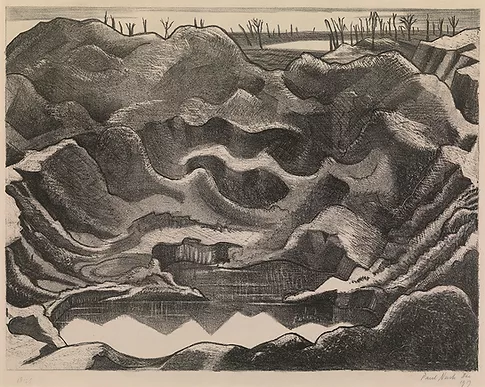
Before the war, both artists studied at the Slade School in the same year and whilst they were under the same tutelage, their styles were significantly impacted by their home environments. Nash’s family moved from London to the commuter belt village of Iver Heath, Buckinghamshire in 1902 when he was 13. His mother was mentally ill and it was hoped that the fresh air and countryside would improve her condition. Unfortunately, her state continued to worsen, and she died in a private hospital in 1910 when Nash was 20. Nash found solace in the countryside and inspired by William Blake, Samuel Palmer and Dante Gabriel Rossetti, his early work was highly symbolic and pre-occupied with ‘visions of romantic death’. Nature as a symbol of humanity enthralled him and dominated as a subject throughout his career. “I have tried to paint as tho’ they were human beings … because I sincerely love & worship trees & know that they are people & wonderfully beautiful people.” Nash was also a poet, and symbols of nature would become the language through which he would communicate. He saw trees as otherworldly, connected to the underworld with their roots below the ground, and to the heavens, their branches extending skywards. On first reaching the front, he was in awe of the war-torn landscape. On 6th April 1917, he wrote in a letter home to his wife Margaret:
“Oh, these wonderful trenches at night, at dawn, at sundown! Shall I ever lose the picture they have in my mind. Imagine a wide flat landscape flat and scantily wooded and what trees remain blasted and torn, naked and scarred and riddled. The ground for miles around furrowed into trenches, pitted into yawning holes in which the water lies still and cold or heaped with mounds of earth, tangles of rusty wire, tin plates, stakes, sandbags. I think it is the only significant landmark left… I feel very happy these days, in fact, I believe I am happier in the trenches than anywhere out here. It sounds absurd but life has a greater meaning here and a new zest, and beauty is more poignant.”
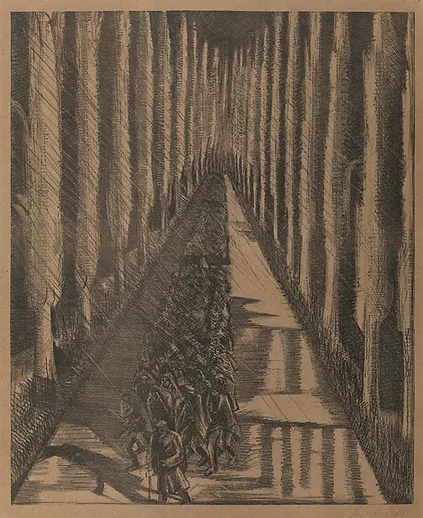
Nash was struck by the perseverance of nature, writing in another letter home to his wife that was later reproduced in his autobiography, Outline:
“The most broken trees even had sprouted somewhere and in the midst, from the depth of the wood’s bruised heart poured out the throbbing song of the nightingale. Ridiculous mad incongruity! One can’t think which is more absurd, the War or Nature…”
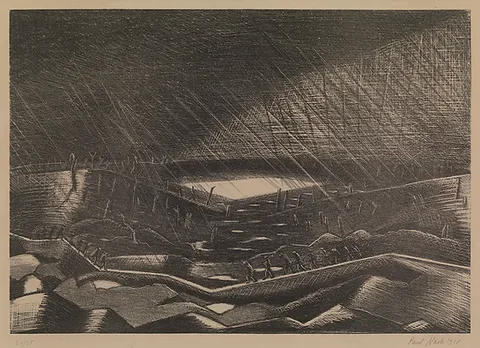
That landscape would soon however take on a threatening air. Left standing on an otherwise barren battlefield, lone trees were used as registration points for artillery fire. For Nash, the tree came to stand as a totem for the human body where depiction of the brutal reality was too painful. The shattered woods of the Ypres Salient in Nash’s work stand for both the physical and psychological damage of war. Art historian Paul Gough writes: “In the Ypres Salient he was aghast at the sight of splintered copses and dismembered trees, seeing in their shattered limbs an equivalent for the human carnage.”
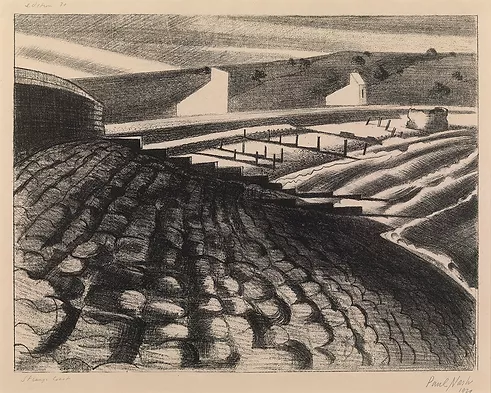
Nevinson’s background was rather different. He grew up in a highly politicised household. His father, Henry, was a famous journalist and war correspondent and his mother, Margaret, was a writer and suffrage campaigner. Surrounded by some of the most avant-garde thinking of the day, Nevinson was comfortable holding unpopular opinions (though this would later prove to be to the detriment of his career). Modern art that had appeared in Europe in the decades before the war was not popular in the UK. Even tutors at the Slade School in London discouraged their students from visiting exhibitions of such work for fear they would be influenced by it. Nevinson disregarded this advice, becoming one of the first British artists to embrace these new artistic developments. He spent time in Paris from 1912-13 where he met Picasso and, significantly, the leaders of the Futurist movement, Filippo Marinetti and Gino Severini. The movement, launched in 1909 with the publication of Marinetti’s Manifesto of Futurism, glorified modernity and, stylistically inspired by Cubism, sought to convey speed and movement. Nevinson became captivated with the expression of the dynamism of modern city life. His new-found style would also prove potent in the representation of the first modern, mechanised war. In ‘Returning to the Trenches’ the soldiers become whirring cogs in one continuous moving line of an army machine. Their legs are a blur of movement, reminiscent of Giacomo Balla’s ‘Walking a Dog’, 1912. Although Nevinson sympathised with Futurist ideals, after experiencing the War at first hand in the autumn and winter of 1914 he would no longer agree with their principles regarding violence and the cleansing nature of war, later saying that “Futurism was but the candlelight for fascism”.
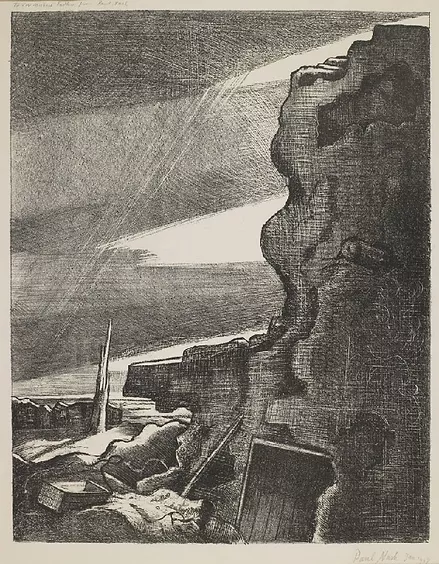
Both young artists volunteered soon after the outbreak of war. Nash enlisted as a Private in the 28th Battalion London Regiment, fondly known as the Artists’ Rifles for its history of attracting artists, poets, architects and actors from its inception in 1860. Nash would later claim to be an unwilling volunteer, though his wife Margaret would remember it quite differently in her memoir: “He had a very clear and simple conception of his duty towards his country, which he passionately loved, and although he was the last human being in the world to tolerate the horror and cruelty of war, he had an immediate and firm conviction that he must fight for England.”
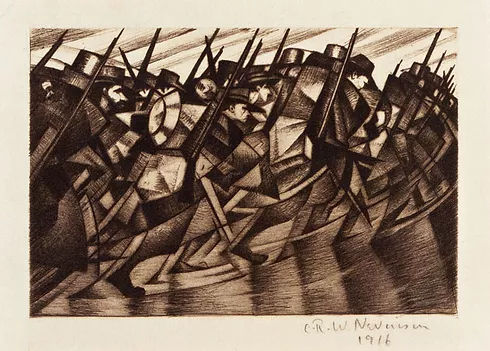
Nevinson volunteered as a motor mechanic in the Friends Ambulance Unit, which his father helped to establish. In November 1914 he was sent to Dunkirk where he was set to work in a series of derailed train carriages that were being used as a make-shift field hospital. With too many injured soldiers and too few doctors to attend to them, the place became known as ‘The Shambles’ after the colloquialism for a slaughterhouse. Nevinson would return to this subject in 1916 in ‘La Patrie’ and ‘The Doctor’ – it was undoubtedly a traumatising experience. He later acted as an ambulance driver before being invalided out due to rheumatism. He later joined the Royal Army Medical Corps and served in the 2nd London General Field Hospital in Wandsworth.
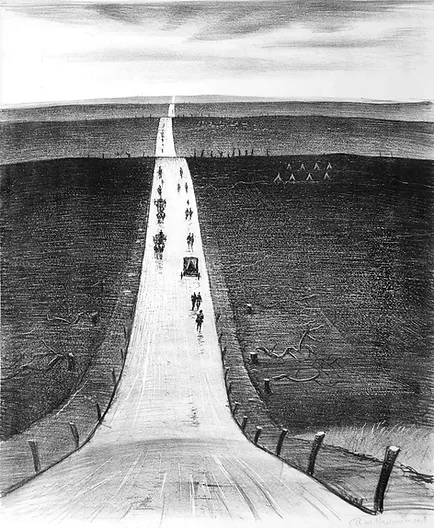
The powerful interpretation of his experiences at the Front were first exhibited in March 1915 with the London Group, which in turn drew the attention of the Leicester Galleries who gave him his first solo exhibition entitled ‘Paintings of War’ in September 1916. The exhibition was a huge success both financiallyand in gaining popular attention. Arnold Bennett, who would go on to become Director of the government’s propaganda (and arts commissioning body), the Ministry of Information, purchased a significant oil painting from the exhibition, as did Sir Michael Sadler, a great supporter of the arts. This would secure Nevinson’s position as one of Britain foremost artists of the war.
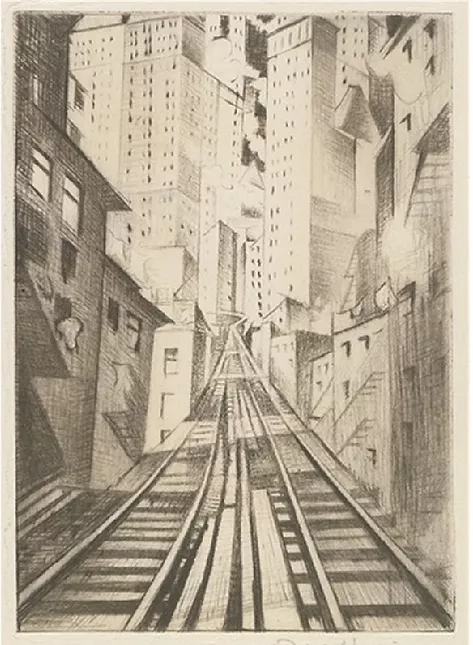
In the December after Nevinson’s hugely successful exhibition, Nash signed up for an overseas posting, having undergone his Officer training. In February 1917, Nash was sent to the Ypres Salient in Flanders with the 15th Hampshire Regiment as a Second Lieutenant. Having only ever made one brief trip abroad, and ever sensitive to his environment, Nash was at first captivated by the French landscape, arriving in a lull between offensives. However, this enamour quickly fell away and he wrote of a wood in a letter home to his wife, “a place with an evil name, pitted and pocked with shells, the trees torn to shreds, often reeking with poison gas.” By March 1917 he had sent a batch of drawings back to England, eighteen of which would be exhibited at Goupil Gallery in June as part of a small solo show, ‘Drawings made in the Ypres Salient by Paul Nash’. Despite the lull, a Spring offensive was not far away, and his unit were to be at the forefront of an attack on the German held Messines Ridge. On Friday 25th May a fellow soldier beckoned Nash out of his dug out to watch a night-time bombardment on the enemy lines. In the darkness, he slipped and fell back into a trench to a roar of laughter from his fellow men, though Nash found this less amusing as the fall broke his rib. He was sent to the No. 14 General Hospital for treatment and anticipating an influx of wounded after the next offensive which could dangerously over-crowd the hospital, he was sent back to England to convalesce. Back at home in London, Nash received news of the 15th Hampshires – prior to the attack on the Messines Ridge, they had been sent to attack ‘Hill 60’ a German held hill south of Ypres near the town of Zillebeke. The Hampshires lost most of their officers in the attack. Hill 60, which would become a subject repeated by Nash, was blown up in the Battle of Messines later in 1917. Nash’s injury also spared him the third battle of Ypres, commonly known as the battle of Passchendaele. Most historians place the British casualties of that offensive alone at nearly a quarter of a million. It could not have been far from Nash’s mind that he so easily might have been one of them. Nash was discharged in August and attached to the 3rd Reserve Battalion of the Hampshires at Gosport. It was whilst preparing to return to the front that Nash received news that he was to be an official war artist. Although this only delayed his return to active combat, Nash’s luck meant that for the duration of the war he would not return to fight.
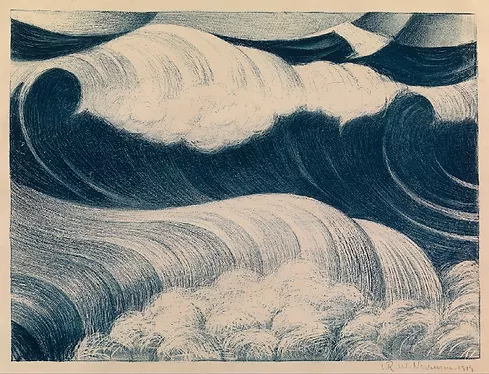
For both Nash and Nevinson the war not only radicalised their work but also introduced them to the medium of printmaking. Printing was a medium favoured by the propaganda wing of the government commissioning the official war artists as it allowed for a wider dissemination. Nevinson produced his first prints in the summer of 1916 (after a brief experiment with lithography in 1912), the result of which was a series of 12 drypoints exhibited at the Leicester Galleries in September 1916. This exhibition came to the attention of Campbell Dodgson, Keeper of Prints and Drawings at the British Museum and unofficial advisor to the newly created government propaganda section, the Department of Information (DOI). Dodgson was particularly impressed by Nevinson’s printmaking and recommended him to the department for the position of official war artist. In early 1917, he was encouraged by master lithographers Joseph Pennell and Francis Ernest Jackson (co-founders of the prestigious Senefelder Club, dedicated to promoting a wider awareness of the medium), to try his hand again at lithography, and his efforts were exhibited with the club. Dodgson, Jackson and the artist Thomas Derrick proposed that the department should commission a series of 66 prints by 20 artists called ‘Britain’s Efforts and Ideals’. The ‘Efforts’ would be made up of 54 prints and be aimed at the home-front population depicting the war effort at home and abroad. The ‘Ideals’ would be symbolic subjects focusing on the justice of the English cause over Imperial Germany and was supposed to appeal to ‘neutrals’, specifically America. Nevinson was given the ‘effort’ subject of ‘Making Aircraft’ and was given the role of war of official war artist in May 1917. These lithographs brought the new world of air travel to the British public for the first time. Nevinson depicted the patriotic symbol of the British landscape from a new, aerial perspective and his prints of the subject were extremely popular. Exhibited for the first time at the Fine Art Society in July 1917, ‘Britain’s Efforts and Ideals’ as a whole went on to tour the world, travelling to France, America, Canada, and Australia. Nevinson’s notoriety went from strength to strength. The Contemporary Art Society presented his ‘La Mitrailleuse’ to the Tate and he received much praise from critics, particularly for his skill in printmaking. His understanding of Cubism and its focus on creating the perfect composition, alongside his Futurist influenced style made Nevinson perfectly suited to printmaking. Art critic Charles Lewis Hind argued that Nevinson’s visualisation of the war was most successfully articulated in his prints. After his traumatic experiences on the Western Front he found that the very act of marking the plate was therapeutic and wrote to the head of the DOI, C.F.G Masterman, that it “wards off my fits of melancholy which end in sleeplessness’.
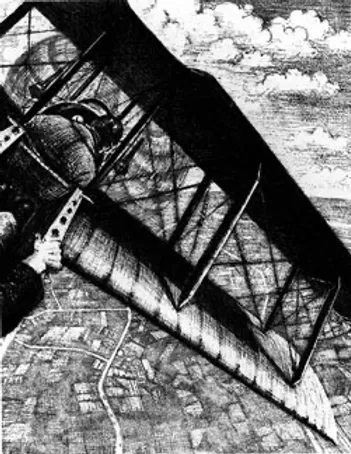
Nevinson also encouraged Nash in printmaking and helped him practice lithography in the summer of 1917. The way Nash’s style had developed during the war lent itself to the medium, with its heavy lines and dark brooding skies. However, it is evident that he admired Nevinson’s work greatly and even owned examples of his prints. In March 1917 he wrote to his wife and asked her to purchase one of Nevinson’s first drypoints, ‘Ypres after the Second Bombardment’. There are similarities between many of their war subjects. In ‘After a Push’ and ‘Mine Crater (Hill 60)’ both artists were faced with an expanse of cratered destruction. This was a problem for many of the official war artists – how to articulate the void created by conflict. Fellow artist Muirhead Bone agonized over this problem, having in mind to draw broken architecture; “I’m afraid that I have not done many ruins… But you must remember that on the Somme nothing is left after such fighting as we have had here – in many cases not a vestige of the village remains let alone impressive ruins!” Nash and Nevinson dealt with this problem, in the manner of their European modernist forebears, bringing the horizontal plane up vertically like a wall to confront the viewer, raising the horizon line to the very top of the composition. Other works such as ‘A Flooded Trench’ and ‘Void of War’ also use similar compositional devices to draw the viewer through the devastated space.
Nash would only make seven lithographs of war subjects, commissioned by the Ministry of Information (the title of the reorganized DOI) and exhibited at the Leicester Galleries in 1918. On 5th July 1917 Nevinson returned to the front in his official capacity, and shortly after his arrival was transferred to the 4th Infantry Division near Arras where he was able to get close to the fighting. He travelled up and down the trenches observing life on the front line. He cajoled the Royal Flying Corps to let him go up in a reconnaissance plane as a passenger to view the action from above, whereupon the plane came under fire. He also spent the night in an observation balloon above the Somme. Although some of these accounts, laid out in his autobiography Paint and Prejudice, have been brought into question (the work is rife with fabrication), it is without question that Nevinson repeatedly placed himself in harm’s way in order to convey the truest picture of the war to his audience back home, and he did not emerge from his experiences unscathed. In the summer of 1918 he was invalided out of the army for good with ‘air nerves’. Not then properly understood, ‘shell shock’ or nerves as they were simply known, were treated with such invasive and damaging procedures as electric shock therapy, beatings and chloroform inhalation.
Nash’s period of convalescence in the summer of 1917 ended with his appointment as an official war artist in October whereupon he returned to the front in November for a six-week period. Like Nevinson, he returned in more agreeable circumstances than his last visit (he was given a batman and a driver), however he arrived during a period of particularly heavy fighting in Ypres. The devastation of the landscape was worse than when he had last been there and in the wintry climate it seemed more hostile and terrible than ever. Nature, instilled in the British psyche as almost sacred, had been utterly defiled and he was angered and appalled by what he considered a ‘terrible new world’.
While Nevinson and Nash may have been commissioned and supported by the ‘propaganda’ department, their work was anything but. The spring of 1918 brought with it Nevinson’s most notable and infamous exhibition. Opened by Lord Beaverbrook, the new Minister of Information, the exhibition flaunted a picture that had been banned by the official censor of paintings and drawings in France, Lieutenant-Colonel A.N. Lee. The picture, ‘Paths of Glory’, which depicted two dead British soldiers was covered with a piece of brown paper with the word ‘censored’ written across it. The bitterly ironic title is taken from Thomas Gray’s ‘Elegy Written in a Country Church-Yard’ – the full line reads ‘Paths of Glory lead but to the grave’.
Nash’s exhibition at the Leicester Galleries in May of the same year, entitled ‘Void of War: An Exhibition of Pictures by Lieutenant Paul Nash’, was well received well and praised for its clear and moving depiction of the landscape. Arnold Bennett in the exhibition’s catalogue essay wrote, “Lieutenant Nash has seen the Front simply and largely. The convention he uses is ruthlessly selective; the wave-like formation of shell- holes, the curves of shell-bursts, the straight lines and sharply defined angles of wooden causeways, decapitated trees, the fangs of obdurate masonry, the weight of heavy skies…”.
The Armistice was signed on 11th November 1918 and whilst the Imperial War Museum would continue commissioning artists until the early 1920s, Nash and Nevinson became war artists without war. Nash in particular was deeply troubled by this thought and the subject of war would haunt his work in the years to come. He visited the Kent village of Dymchurch for the first time in 1919, moving there in 1921 when he suffered an acute nervous breakdown. He found the place inspiring and wonderful with its monumental sea wall protecting the coast from the ravages of the North Sea. However, there is a darkness surrounding the works of Dymchurch, seen in ‘The Bay’, as though the threat of war has been replaced by that of the sea ready to engulf the figures. In ‘Strange Coast’ an eerie sense of stillness pervades the scene and an unnatural light causes the little posts on the beach, reminiscent of his wartime trees, to cast long shadows up the beach.
Nevinson however dropped the subject of war after the Armistice and returned to France in 1919 to visit Paris, reconnect with old friends and see the new work by Picasso. Later in the year he travelled to New York where Frederick Keppel & Co held an exhibition of his work, predominantly the war subjects. Thrilled by the architecture and geometry of the city, he described the skyscrapers as the most vital art works of the day. The city embodied the Futurist ideals that had so excited him before the war. The following year Nevinson returned to New York to exhibit work from the previous year inspired by the city again at Frederick Keppel’s. The second exhibition was not a success, a fact which Nevinson took to heart. He turned against the city re-naming one of his paintings, the same subject as ‘New York: An Abstraction’, as ‘The Soul of a Soulless City’.
After the war Nash would turn his hand to Wood-engraving, most notably producing a two-volume book edition of his prints, Places and Genesis as well as illustrating works by Robert Graves, Siegfried Sassoon and T.E. Lawrence’s Seven Pillars of Wisdom. Nevinson was advised by his doctors to give up printmaking, etching in particular, as the acid fumes were damaging his lungs. His final print was ‘The Spirit of Progress’ created for a magazine, The Studio, in 1933.
Both Nash and Nevinson died at the age of 57. Nash died in his sleep in July 1946 of heart failure supposedly brought on by long term asthma. Nevinson suffered a series of severe strokes that left him partially paralysed. He died in October of the same year of heart disease. Over a century after the Armistice, Nash and Nevinson’s prints remain some of the most poignant and moving images of the Great War.
View available prints at Osborne Samuel Gallery.
